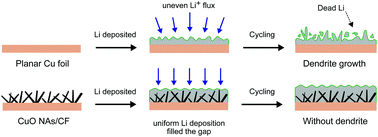MOF-derived lithiophilic CuO nanorod arrays for stable lithium metal anodes†
Abstract
Lithium (Li) metal is regarded as the most promising anode material for next-generation high energy density rechargeable batteries. However, the uncontrolled growth of Li dendrites and the infinite volume expansion of Li decrease the coulombic efficiency and cause safety concerns. One of the best strategies to solve these problems is engineering a nanostructured interface on the current collector. Thus, in the present paper, to regulate Li nucleation and suppress the growth of Li dendrites, metal–organic framework (MOF)-derived CuO nanorod arrays with lithiophilic groups were synthesized on a Cu foil current collector (CuO NAs/CF). The CuO nanorod arrays with the N-containing group in CuO NAs/CF not only acted as lithiophilic active sites to reduce the nucleation barrier to Li deposition, but also decreased the current density and homogenized the Li-ion flux distribution. The CuO NAs/CF electrode showed a high coulombic efficiency of 98% for more than 180 cycles at 1 mA cm−2 and excellent cycling stability with a low overpotential of 30 mV for 600 h in symmetric cells. Based on the Li–CuO NAs/CF composite anode, full cells with a LiFePO4 cathode showed improved cycling stability, small polarization, and flat voltage curves compared with the cells using a planar Cu current collector. This work provides a new strategy for designing MOF-derived materials for stable, dendrite-free lithium metal anodes.

- This article is part of the themed collection: 2020 Nanoscale HOT Article Collection


 Please wait while we load your content...
Please wait while we load your content...